Made with a no-knead, four-ingredient dough, these baguettes have an open crumb and a shatteringly crisp crust. The overall process is simple, but the key to an excellent baguette is twofold: time, which develops flavor, encourages browning, and promotes a light and airy crumb; and baking in a steamy environment, which you can create easily in your home oven. You’ll find step-by-step instructions below.
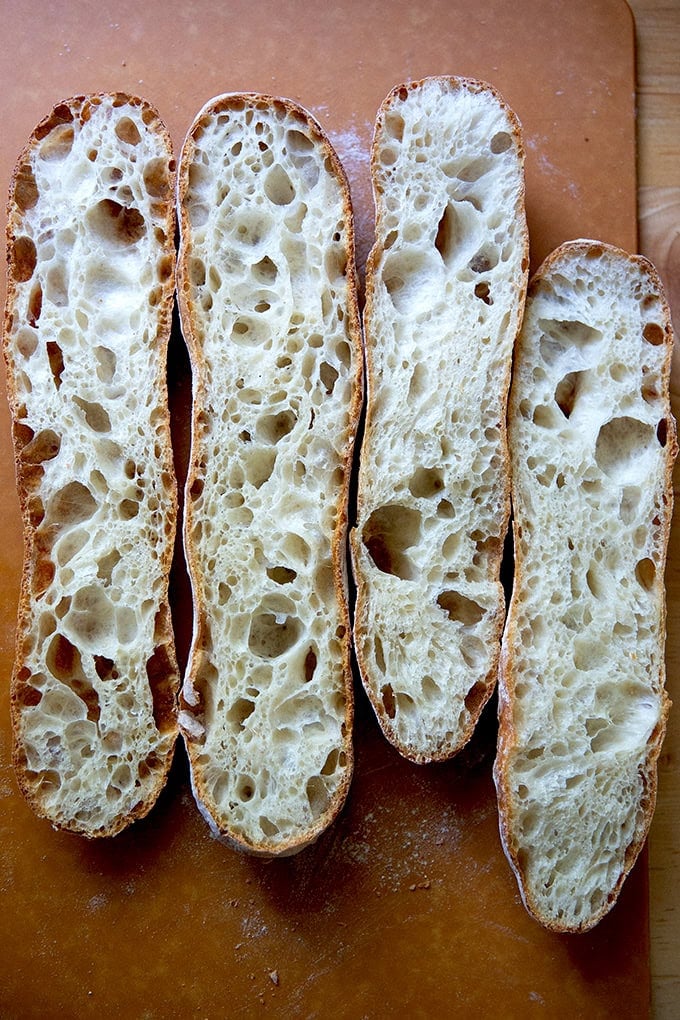

Nearly every week someone writes me asking if I have a baguette recipe. They’ll say: “I checked your bread archives and couldn’t find one, but wanted to make sure I didn’t miss anything.”
They hadn’t!
I’ve hesitated to add a baguette recipe here for a number of reasons, namely because before recently, I hadn’t had much success with them. Over the years I’ve dabbled, but I’ve found the process discouraging from the shaping (requiring very practiced hands) to the equipment (couches, lames, lava rocks) to the baking (demanding steam). Baguettes, I resigned, were best left to the professionals.
But at some point a few months ago, I rolled an extra round of pizza dough into a log, threw it in my Challenger Bread Pan, and baked it. And when it emerged golden and crusty, I felt hopeful. And when I halved it to reveal a wild amorphous crumb, I nearly cried.
Kidding. However, there is something very satisfying about producing a deeply burnished, light and airy baguette, in your own kitchen.
Since this first successful bake, I have experimented with a number of different baking methods, and in this post, I have outlined the two (actually three… see below) I’ve had the most success with: one calling for the Challenger Bread Pan or other oval-shaped Dutch oven and the other for a Baking Steel or baking stone plus a turned-over disposable aluminum pan.
What do the two methods have in common? They both use a lid for the first ten minutes of the baking process. Why? To create steam. And why is steam good? Let’s jump right in.
Warning: This post gets a little nerdy. I consulted two books, Chad Robertson’s Tartine Bread and Jeffrey Hamelman’s Bread, while writing this post. Know this: if I can get it, so can you!
Why is steam good for baguettes?
Steam is good for baguettes (and many breads, such as this simple sourdough bread recipe and Jim Lahey’s no-knead bread) for two reasons: oven spring and crust development (both color and texture).
Let’s start with oven spring. First of all: what is oven spring? In short, oven spring is exactly as it sounds: dough springing in the oven upon entry.
Dough springs in the oven for a few reasons: 1. Increased fermentation activity, meaning as the yeasts rapidly multiply in the hot oven, the dough produces carbon dioxide gas. 2. Steam: As water in the dough evaporates it transforms into steam. Both the carbon dioxide gas and the steam push against the gluten structure, causing the dough to spring.
A moist, steamy environment allows for maximum oven spring because it allows the dough to expand to its fullest potential before a crust forms. In other words: when dough stays soft during the early phases of baking, its oven spring will be greater because it isn’t being restricted by a dry, hard crust.
And the reason we want dough to spring to its potential is because a greater spring promotes a crumb that is light and airy.
Make sense?
Now onto crust color and texture. In the early stages of baking, the rapid increase in enzymatic activity on the surface of the loaf breaks down the starches in the dough into simple sugars. These sugars ultimately contribute to crust color. In a steamy environment, the enzymes remain active for longer, leading to an even richer color.
A steamy environment will also help produce a crust with a subtle sheen. This is because, during the early stages of baking, the starches on the surface of the loaf gelatinize — meaning they swell with water, and as they break down, they form a gel. During the last 10 minutes of baking, when the lid is removed and the baguettes are baking in dry heat, that gel layer dries out, transforming into a shiny crackly crust as opposed to one that is dull and hard.
Compare the two photos below. This first one shows a baguette baked with steam:
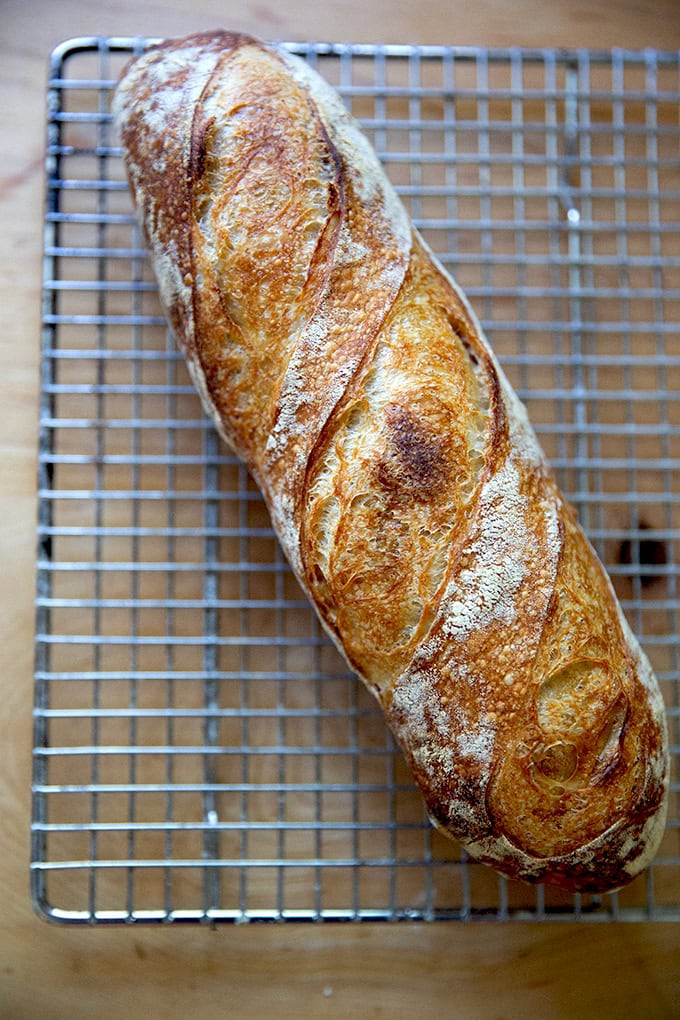

In the below photo, the baguettes were baked on the Baking Steel without steam. In the above photo, observe the caramelization of the crust, the score differentiation, and the slight sheen. Compare it to the dry, lusterless crusts below:
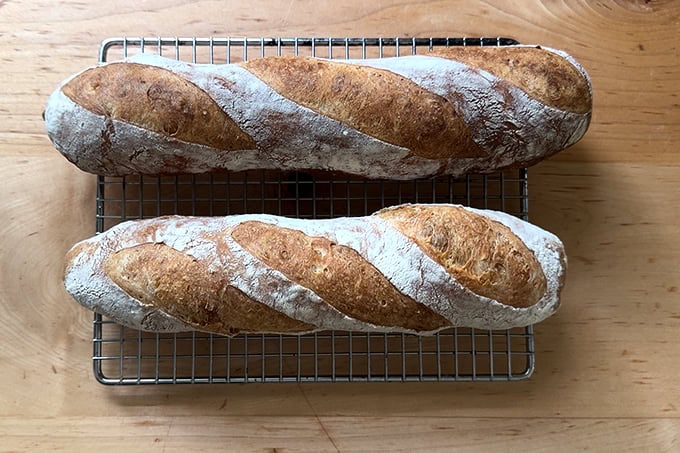

Note: In my experiments, I tried using other methods to create the steamy environment: ice (adding ice cubes to a skillet placed next to the loaf during the first 10 minutes of baking) and water (pouring water into a hot skillet set next to the loaf). While both methods indeed created steam, I found them mostly ineffective in terms of creating a nice crust.
So, to recap: baking in a sealed environment is important to create steam, which is optimal for good oven spring and crust formation. But steam is not the only factor responsible for producing a baguette with a beautifully burnished crust and light and airy crumb.
Time is essential, too.
Why is time good for baguettes?
When dough rises slowly, good things happen: during a long, slow fermentation, enzymes in both the flour and the yeast break down the starches in the flour into simple sugars, which contributes both to flavor and to browning.
If you make your dough at least a day before you plan on baking it, you will see improved flavor and browning. It’s for these reasons, I always make my pizza dough two to three days before I plan on cooking it.
Timelines
This dough calls for a long slow initial rise, roughly 6 to 10 hours depending on the time of year and the temperature of your kitchen. Following this first rise, you’ll ball up your four portions of dough and, ideally, store them in the fridge for a day or two for the above-mentioned reasons: time = goodness.
The beauty of this method is that you can store the dough balls in the fridge for as long as a week, and you can bake off the baguettes one at a time as needed. Unless you are baking for a lot of people, you don’t want to have lots of extra baguettes on hand — while they reheat fine on subsequent days, baguettes are best eaten the day of.
On baking day you’ll want to remove your dough three hours before you plan on baking.
All of this said, you can skip the fridge time all together — find a photo just before the recipe card at the bottom of the post that shows a baguette that experienced no fridge time: the dough was mixed Friday evening; the baguettes were baked Saturday afternoon.
Example Timeline #1: Fridge Time
- Wednesday Evening: Mix Dough
- Thursday Morning: Ball Up Dough, Transfer to Fridge
- Friday Afternoon (or any subsequent afternoon for as long as a week): Remove Dough Ball From Fridge 3 Hours Prior to Baking
- Friday Evening: Bake Baguette
Example Timeline #2: No Fridge Time
- Thursday Evening: Mix Dough
- Friday Morning: Ball Up Dough, Transfer to a Lidded Vessel (such as a DoughMate), Leave at Room Temperature for Two Hours.
- Friday Midday: Shape the Dough Balls into Baguette Shape and Return to Lidded Vessel, Leave at Room Temperature for Roughly Two Hours More.
- Friday Afternoon: Bake the Baguettes
Ready? You got this 🥖🥖🥖🥖🥖
How to Make Baguettes, Step by Step
I’ve broken down this step-by-step guide into three sections:
Part I: Mixing and Portioning the Dough
Gather your ingredients: flour, salt, yeast, and water. I conducted most of my experiments with King Arthur Bread flour, since it is widely available and such a reliable flour. SAF instant yeast is my favorite. See notes in the recipe box regarding salt.
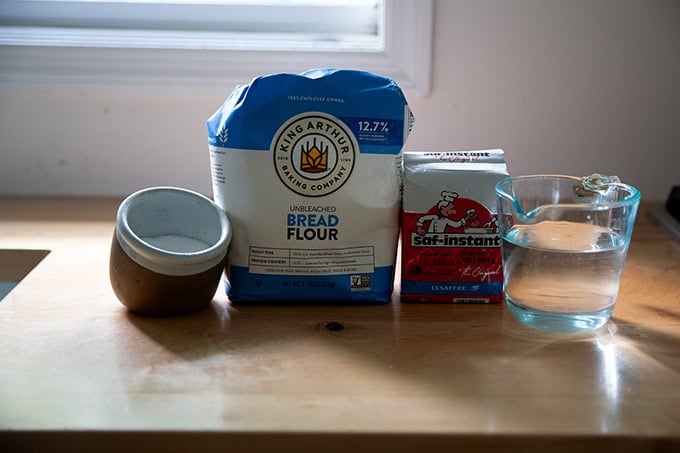

I also had excellent results using this Petra 0102 flour, which is made from partially sprouted wheat flour and which I love for the flavor and texture it lends to a bread or pizza.
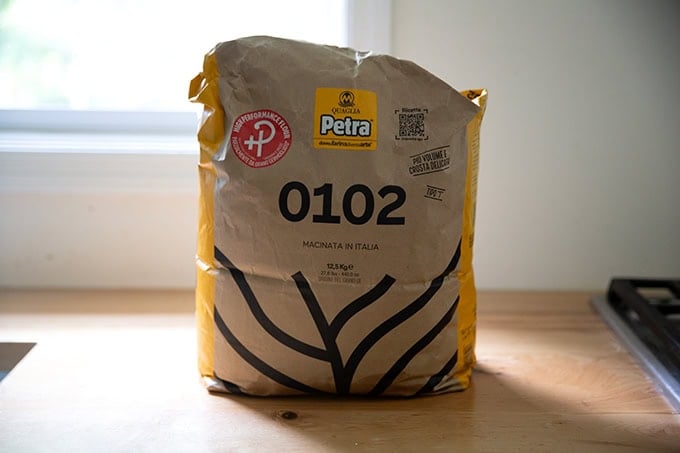

Measure everything out, ideally with a scale:
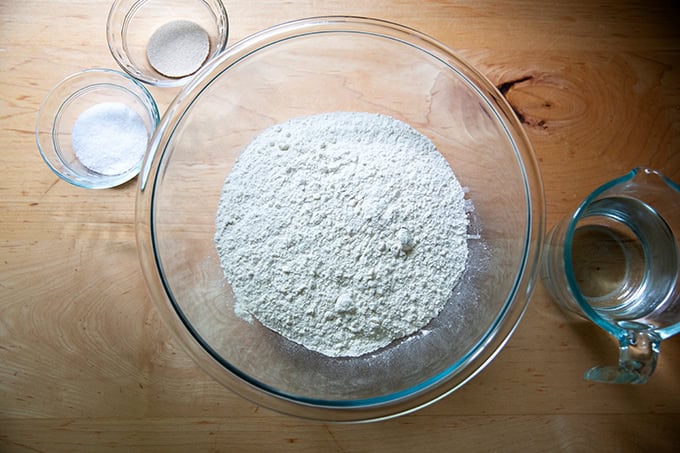

Combine the dry ingredients together first:
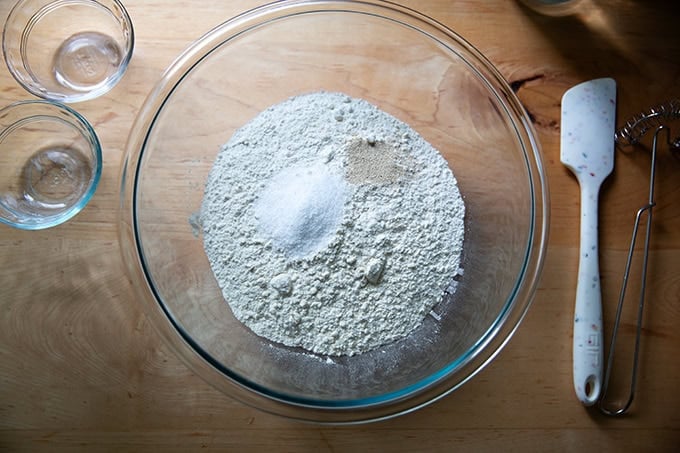

Whisk them together:
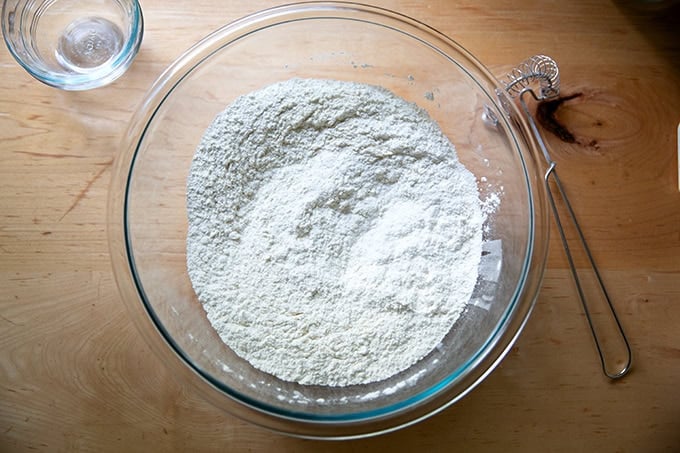

Then add the water:
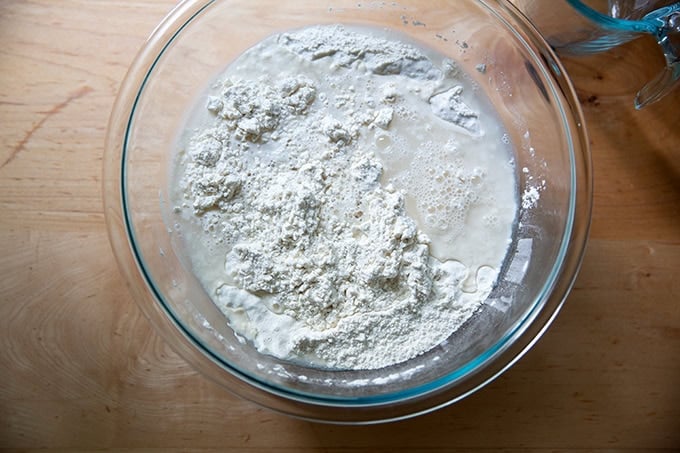

Mix until you have a shaggy dough ball:
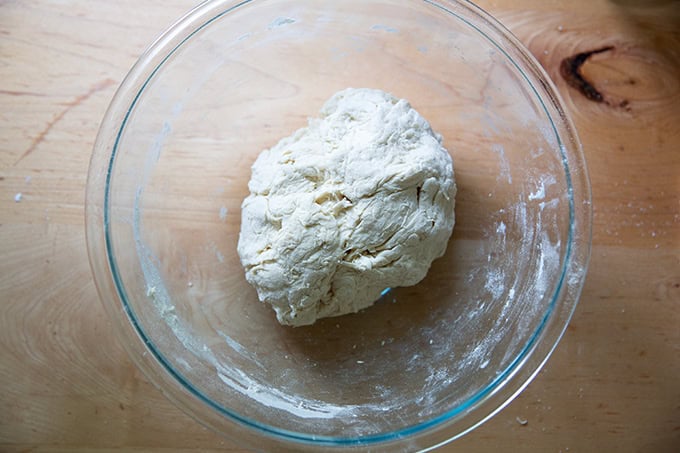

Let it rest for 30 minutes or so, then stretch and fold it (see video for guidance):
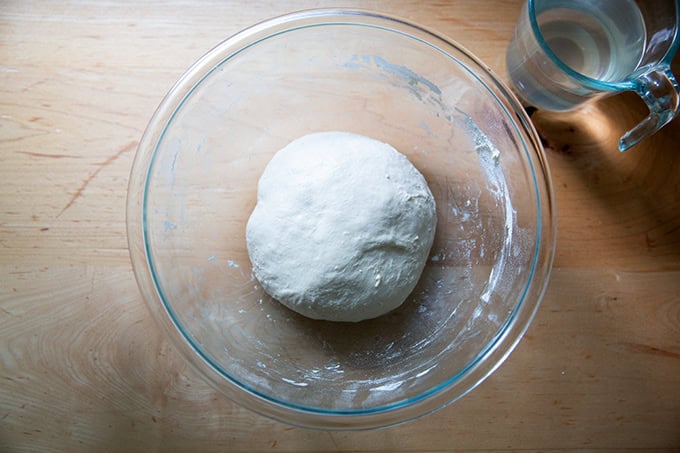

Cover the bowl with an airtight lid, then let it rise at room temperature until it doubles in volume and its surface is covered in bubbles.
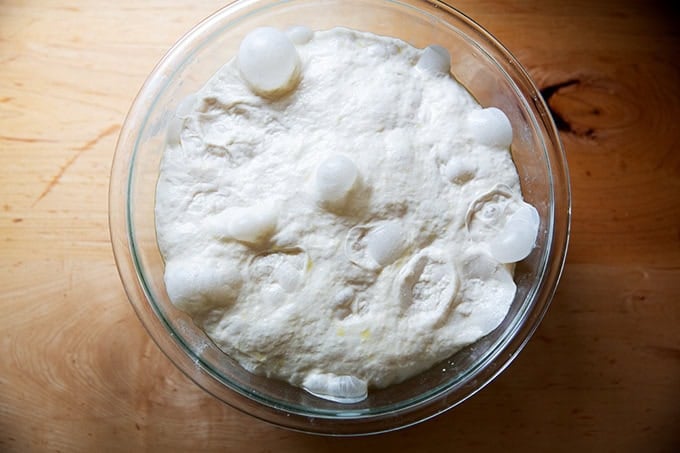

Using lightly floured hand, deflate the dough:
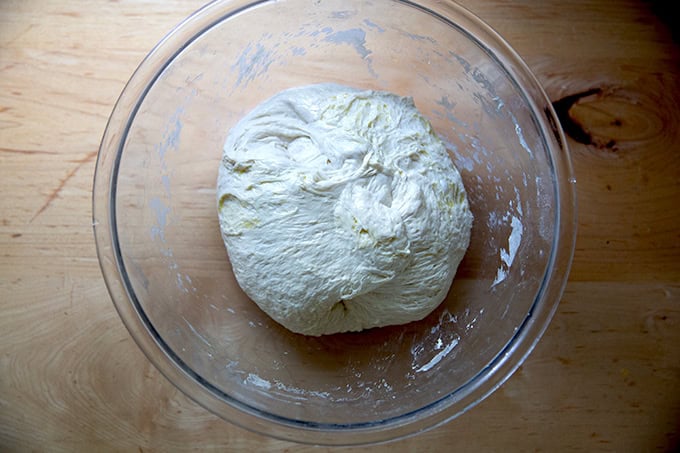

Then turn it out onto a work surface and divide it into four equal portions. I do like to use a scale to ensure each portion is identical, roughly 237 grams each.
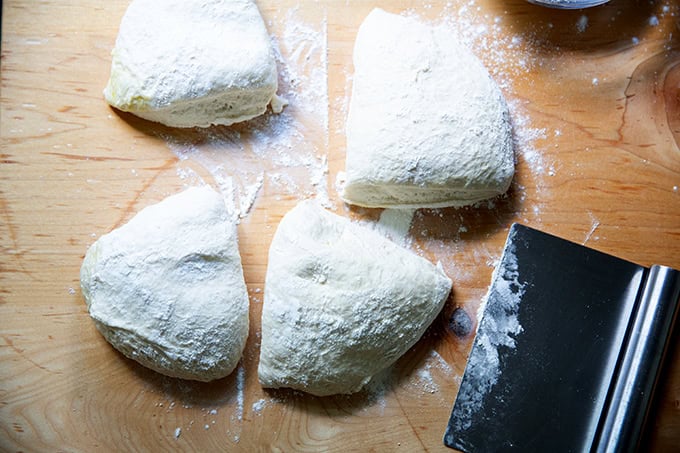

Ball up each portion:
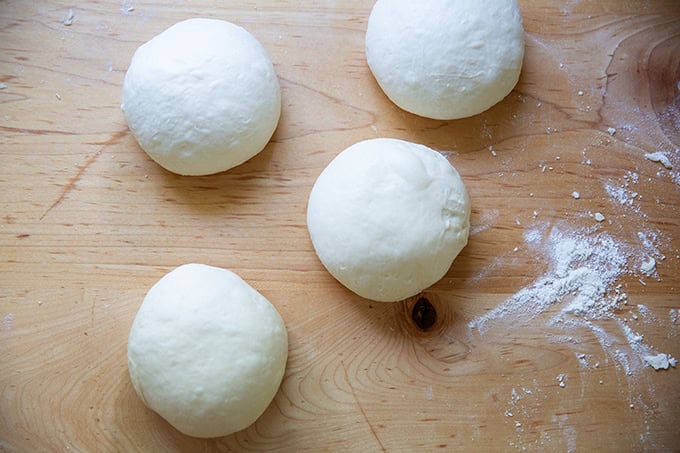

Transfer to storage vessels:
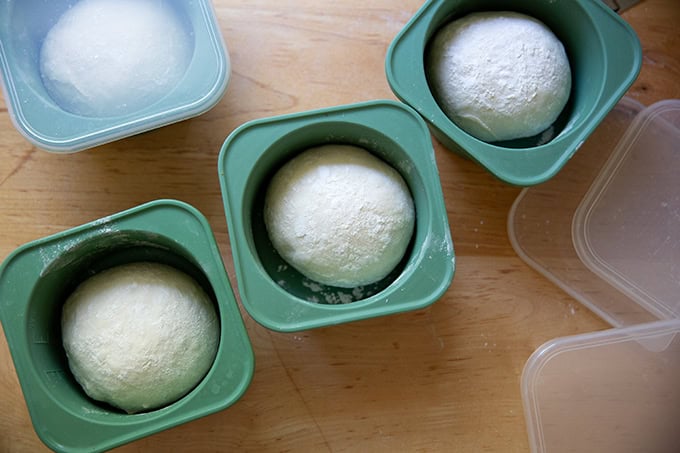

Then transfer to the fridge ideally for at least a day. The dough balls can stay in the fridge for as long as a week.
Part II: Shaping and Proofing
Shaping baguettes takes a little bit of practice, but I find using cold, refrigerated dough makes the process easy. Below you will find video and photo guidance of the process.
On baking day, turn the dough out onto a work surface. I do not use any flour here, but if you find the dough to be sticky, use flour lightly as needed.
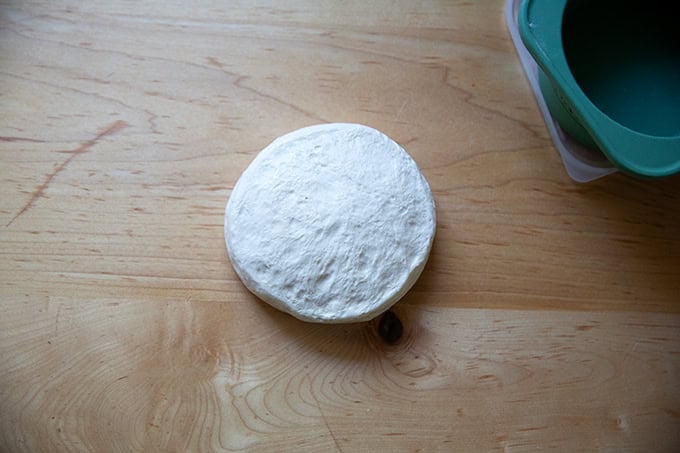

Pat the dough into roughly a 6×7-inch rectangle:
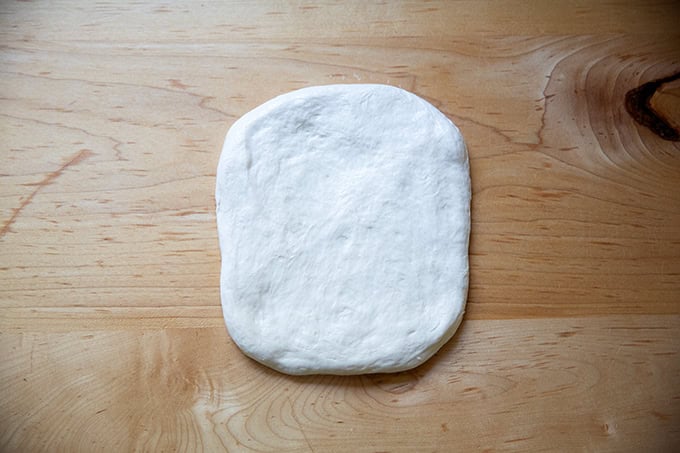

Fold the dough from the top down:
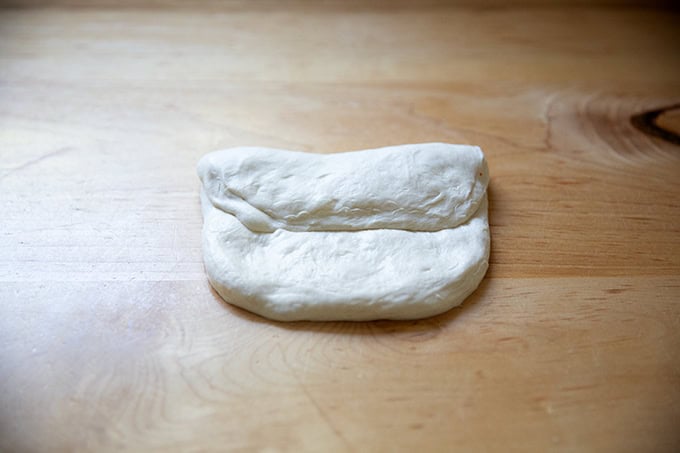

Rotate the dough 180 degrees, and fold from the top down (also known as an “envelope” fold).
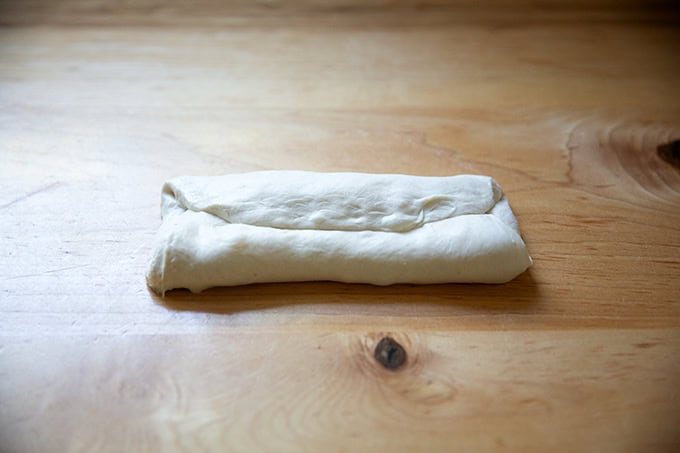

Then fold again from the top down, essentially folding the envelope in half.
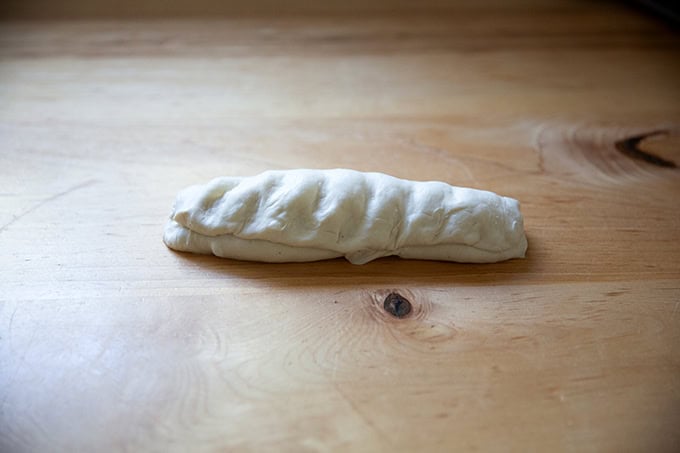

Then, repeat (see video for guidance):
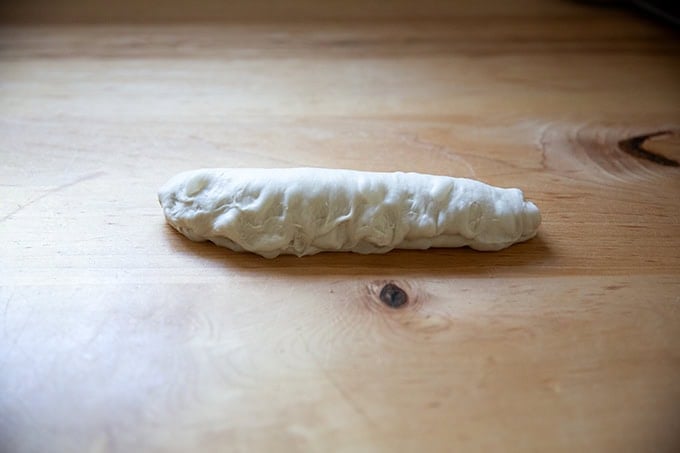

Pinch the seam closed.
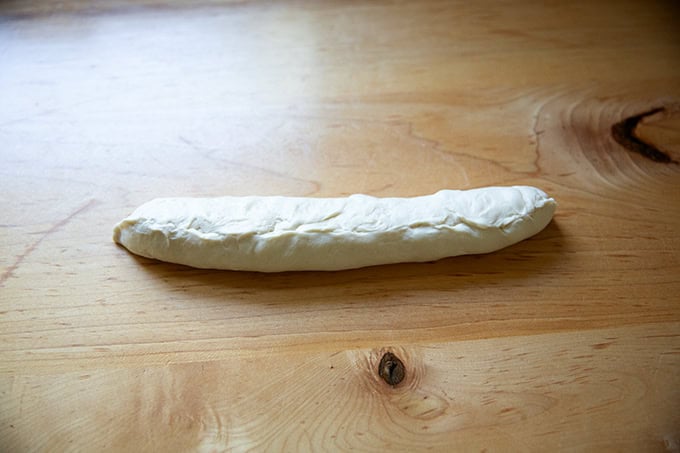

Turn over so that the seam is down and gently roll.
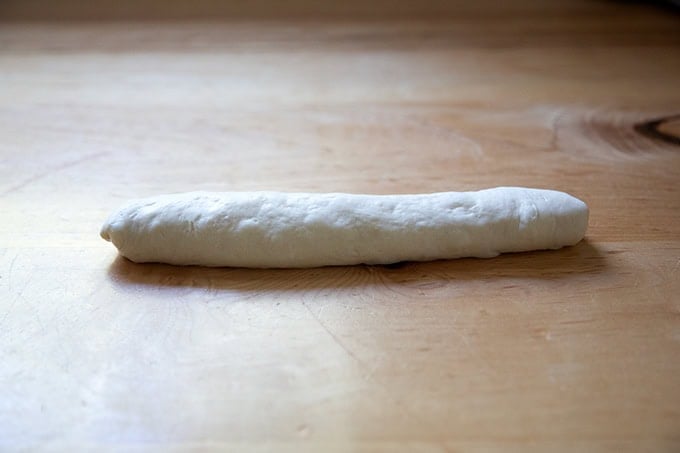

Transfer to a floured, lidded storage vessel. I love these DoughMates, but you could use a large Tupperware or a 9×13-inch dish tucked inside a 2-gallon ziptop bag.
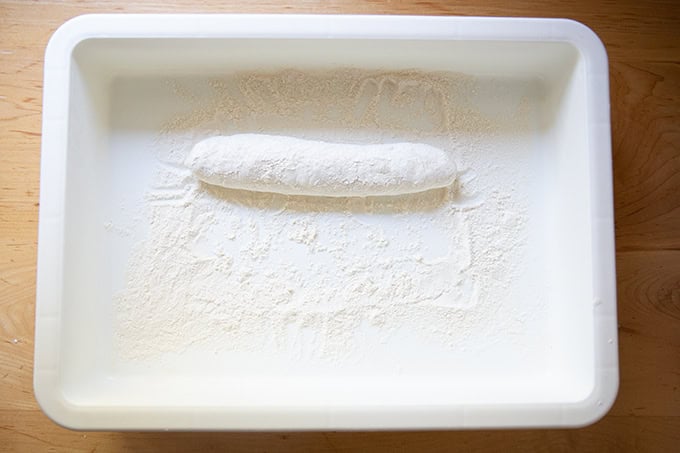

Often I’ll proof two at one time, though I try to stagger the entry of each by 30 minutes so as to avoid overproofing the dough.
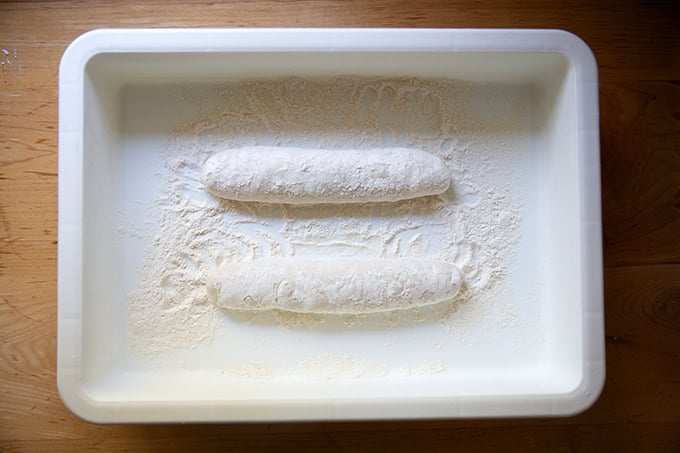

Cover the container and let the dough proof for 2.5 to 3 hours or…
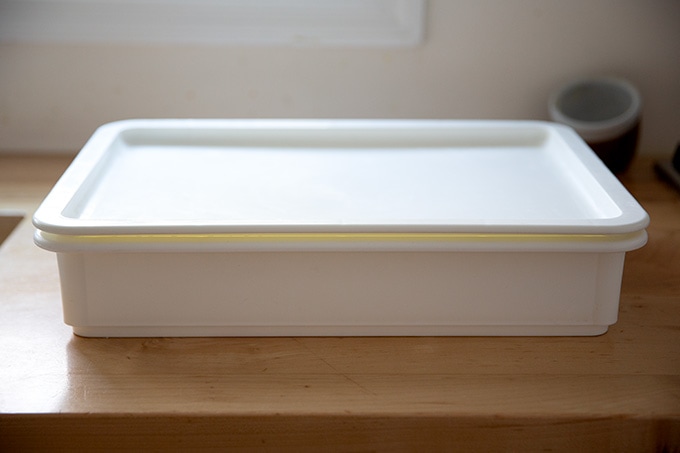

… until it feels very light and airy to the touch. One assessment tool you can use is the “poke” test: using a lightly floured finger, poke the dough making an indentation roughly 1/2-inch deep; if it springs back immediately, the dough needs more time; if it springs back slowly initially, but then holds a partial indentation — in other words, if it doesn’t completely refill — the dough is ready to be baked. (And if it doesn’t spring back at all, the dough is overproofed, but push on anyway, because it may bake up just fine.) I don’t love this method because I find it to be misleading: my dough behaves nearly the same way at the 2-hour mark as it does at the 3-hour mark, and yet my baguettes consistently have a lighter, airier crumb if I wait 3 hours before baking them. Nonetheless, it is a tool you can use.


Part III: Baking
When the dough is ready for baking, remove it from the DoughMate and place it on a sheet of parchment paper — I take full sheets, fold them in half lengthwise, then cut them in half.
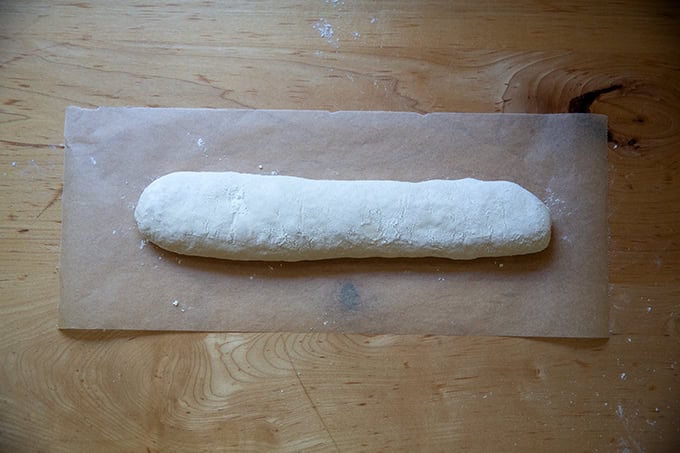

Use a razor blade to score it.
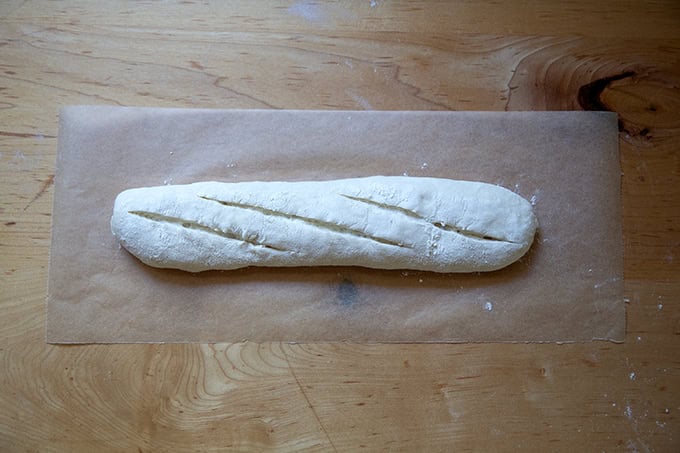

Then bake it…
Method 1: Preheated Challenger Bread Pan. Place the Challenger or other oblong-shaped Dutch oven into an oven and preheat to 450ºF. This takes roughly 30 minutes in my oven. Lower the scored log, parchment paper and all into the preheated pan.
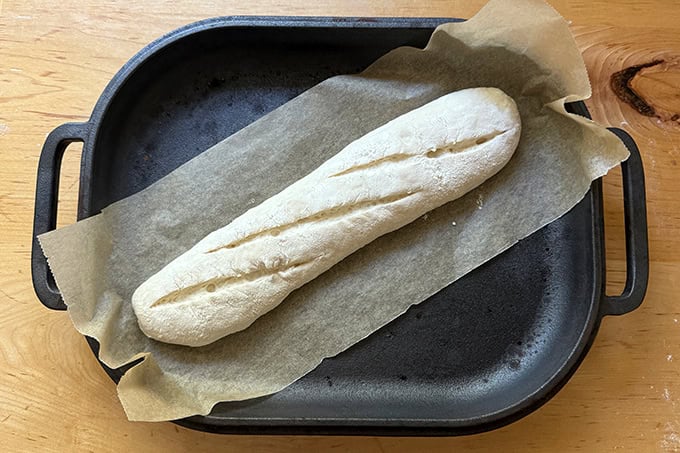

Cover it and return it to the oven for 10 minutes.
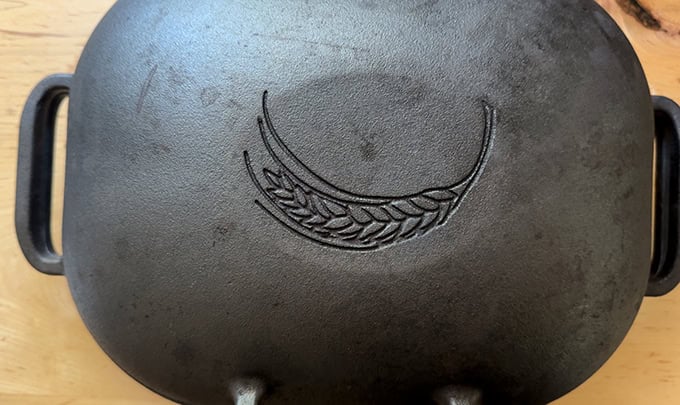

Uncover it, and return it to the oven for another 10 minutes…
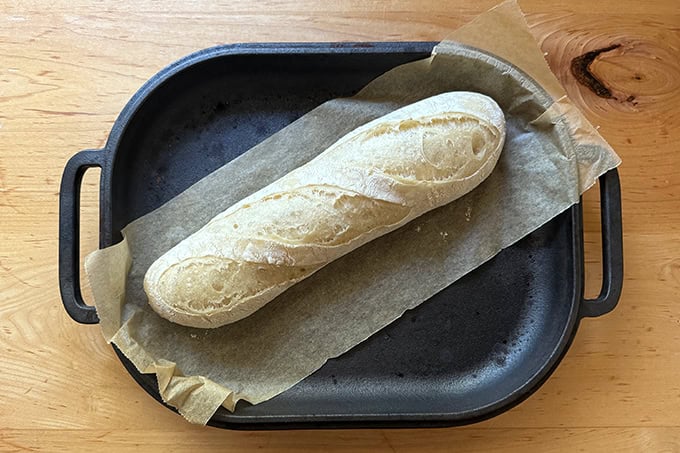

… or until the baguette is beautifully golden brown:
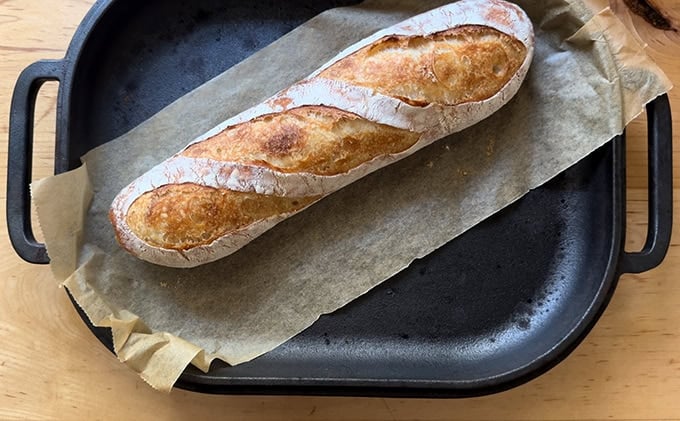

Transfer to a cooling rack. Let cool for 15 minutes or so before…
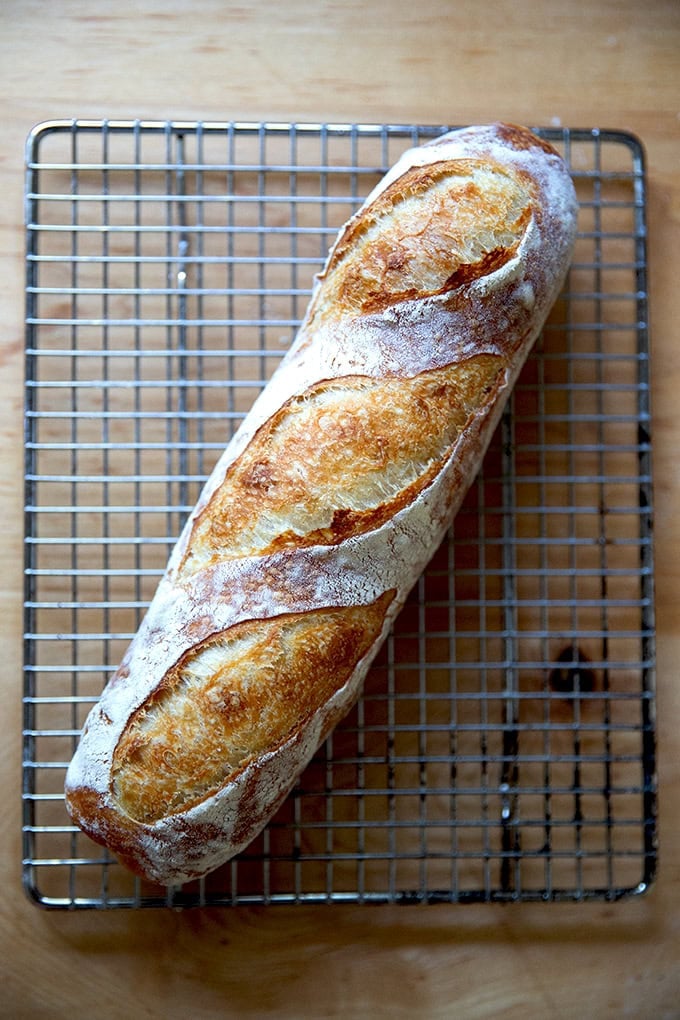

… serving.
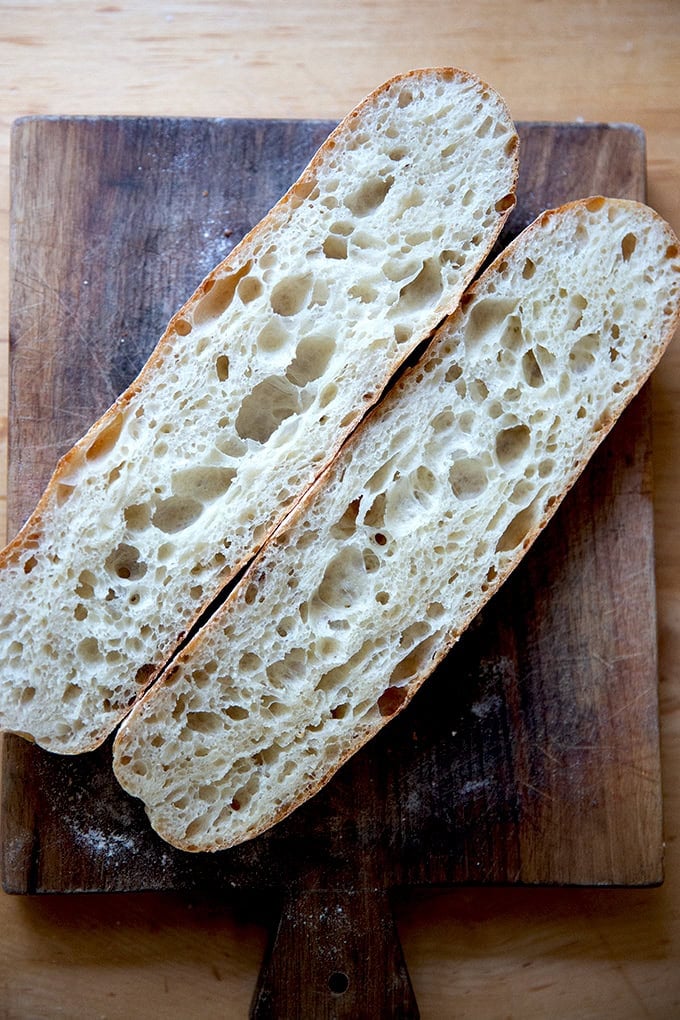

As noted above, I’ve been experimenting with Petra 0102 flour. The baguette on the left is made with Petra flour; the one on the right is King Arthur bread flour.


Left: Petra flour; right: King Arthur bread flour.
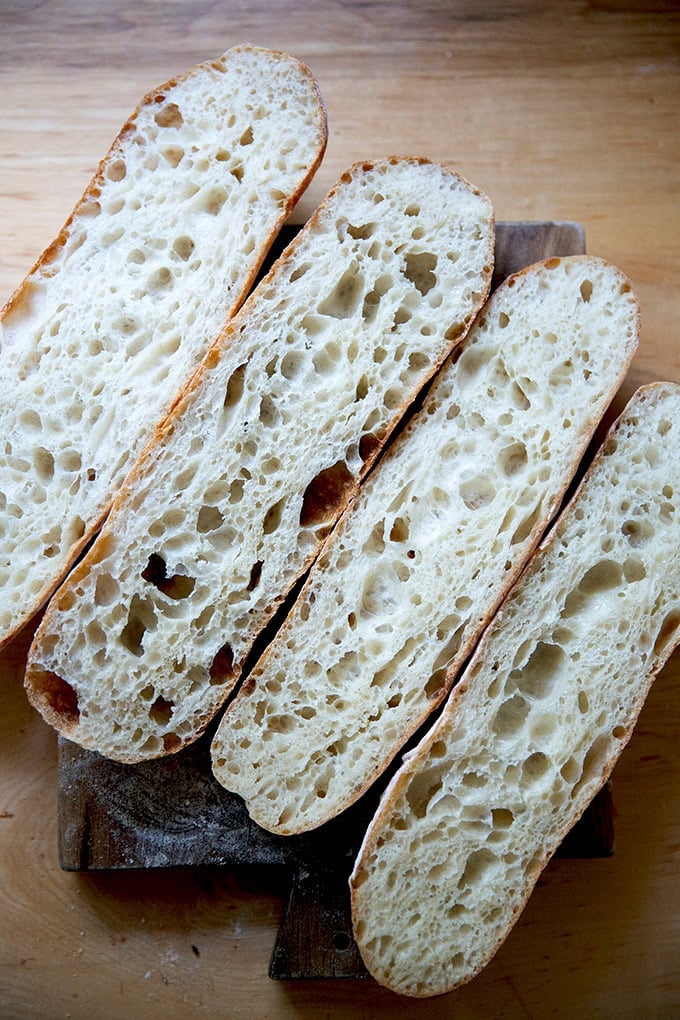

Method 2: Baking Steel or stone. Note: This method is inspired by this post on Serious Eats. Place a Baking Steel (the original or the pro) or a baking stone in the middle of your oven and preheat it to 450ºF. This may take 30 or so minutes.
Score your dough:


Then shimmy it onto the hot Baking Steel or pizza stone using a peel (this is my favorite peel).
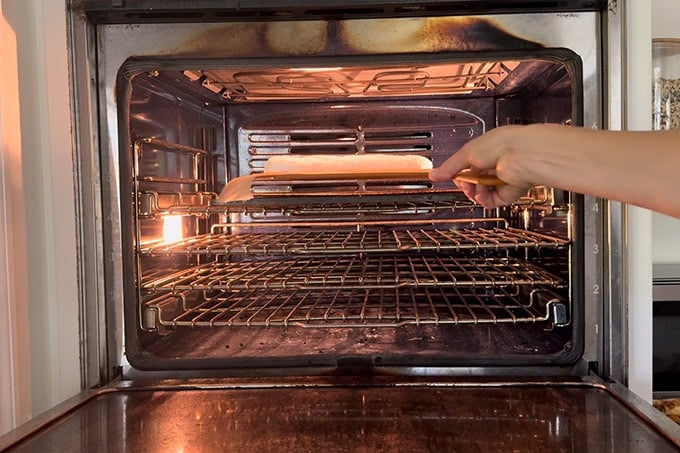

Cover the baguette with a disposable aluminum pan (lasagna-sized) and weigh it down with something heavy enough to seal it down without collapsing it:
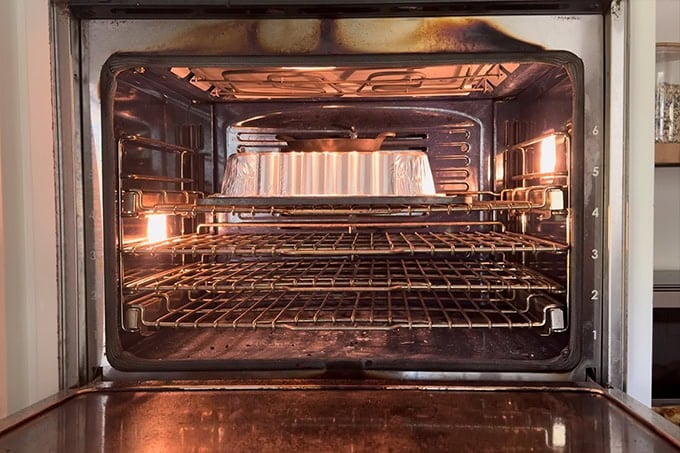

Bake for 10 minutes. Then remove the weight and pan.
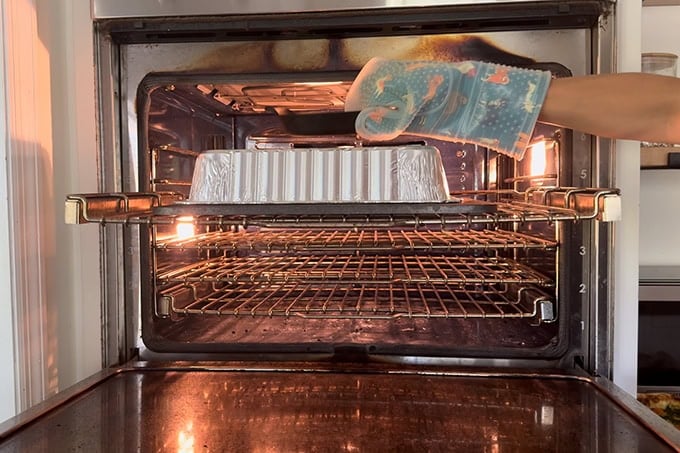

Continue baking the baguette for another 10 minutes…
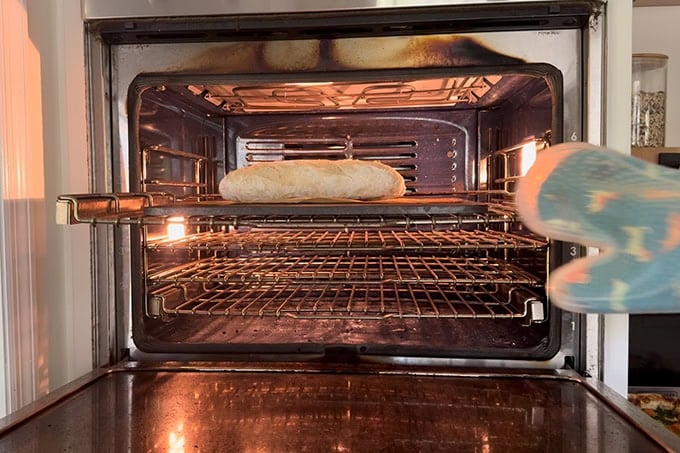

… or until it’s golden and bronzy to your liking:
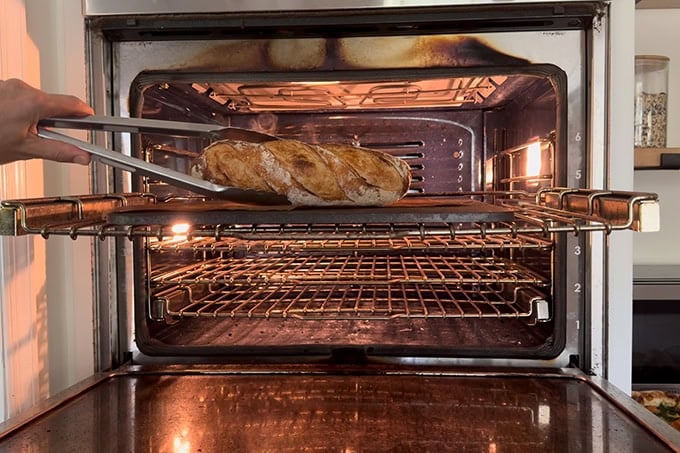

Let cool for 20-ish minutes or so before halving:


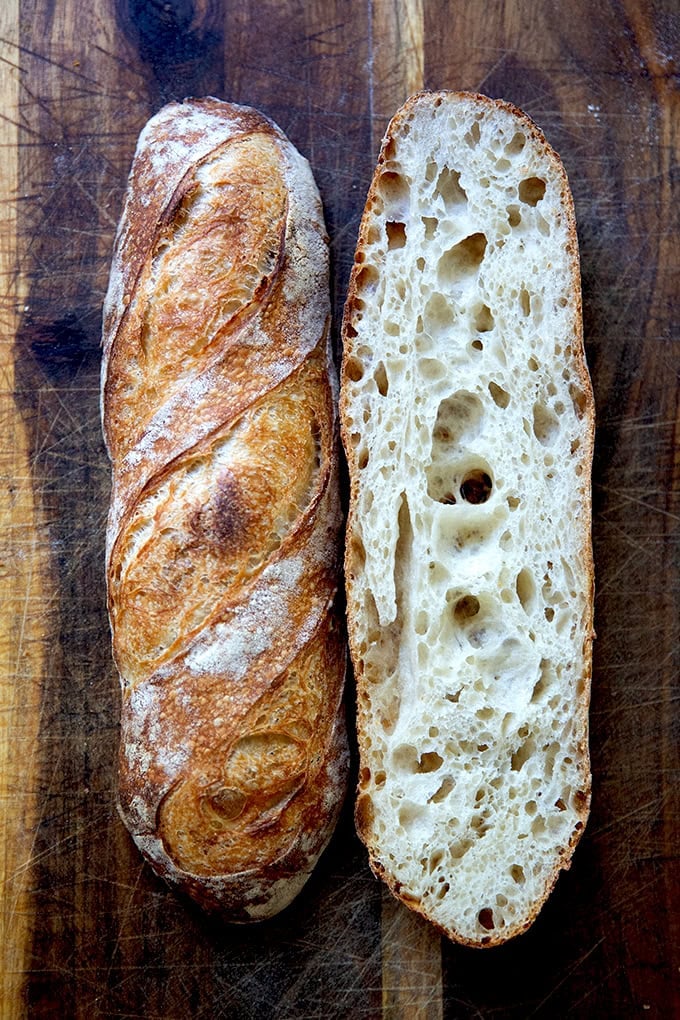

A few other bakes with this method: left Petra; right KAF bread flour.
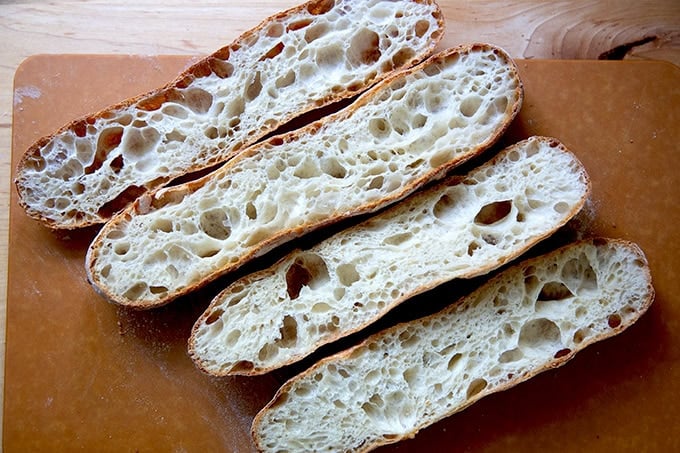

The below pictured loaf is made with KAF bread flour, and this dough experienced no refrigeration: I mixed the dough on Friday night, portioned it and balled it up Saturday morning, let the balls rest in a DoughMate for 2 hours or so, shaped into baguettes and let rest again for another 2 hours; then baked:
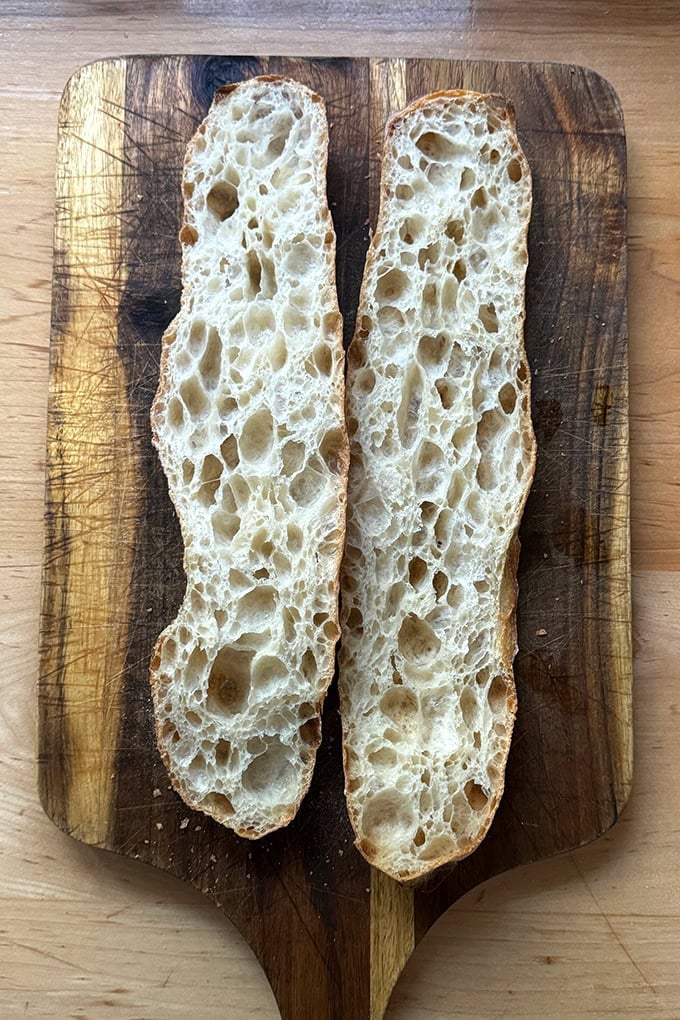

Bonus Method: Covered Emile Henry Baker
I bought this Emile Henry baguette baker on a whim several years ago but it has mostly sat unused in my basement. I pulled it out to experiment because when I mentioned I had been baking baguettes in my newsletter, someone emailed me telling me she had just purchased an Emile Henry baguette baker and was looking forward to using it.
I was incredibly pleased by the results, which consistently produced a beautiful crust if slightly less crusty than the two methods outlined above. The crumb, while light, similarly isn’t as open or airy as the other two methods. That said, it’s still delicious. Moreover, a slightly smaller amount of dough might produce a lighter, airier baguette because it wouldn’t fill the baguette well so tightly.
This method is perhaps the easiest of the three in that you don’t have to preheat a vessel. For this sort of baker, simply place the baguette into the buttered well, score it, then bake covered at 450ºF for 10 minutes and then uncovered for 10 more minutes.
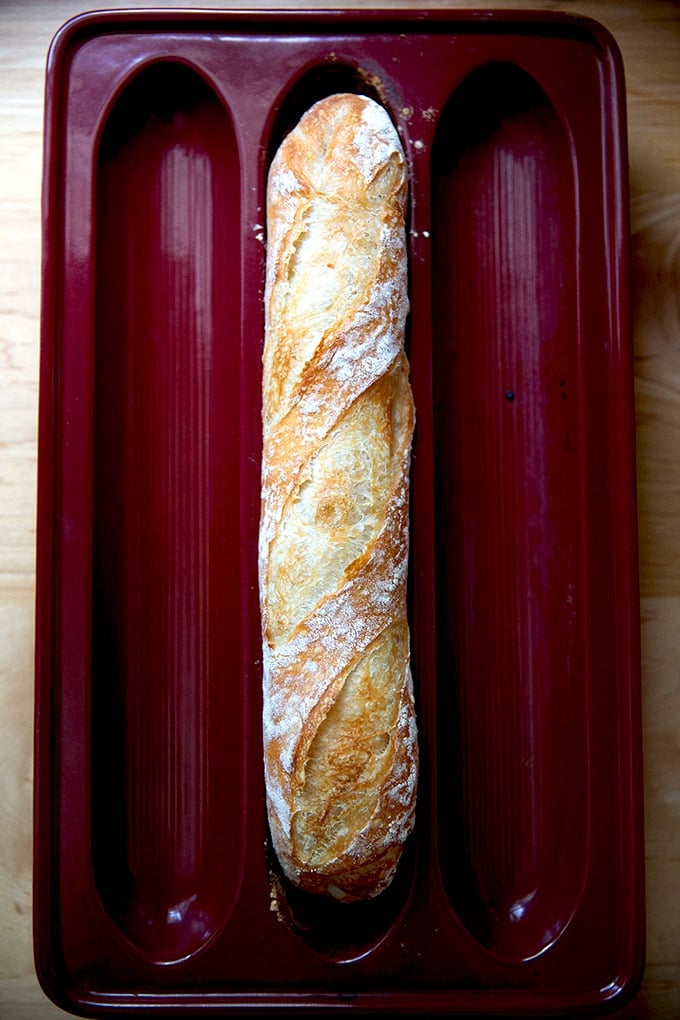

For its ease, this is a great option:
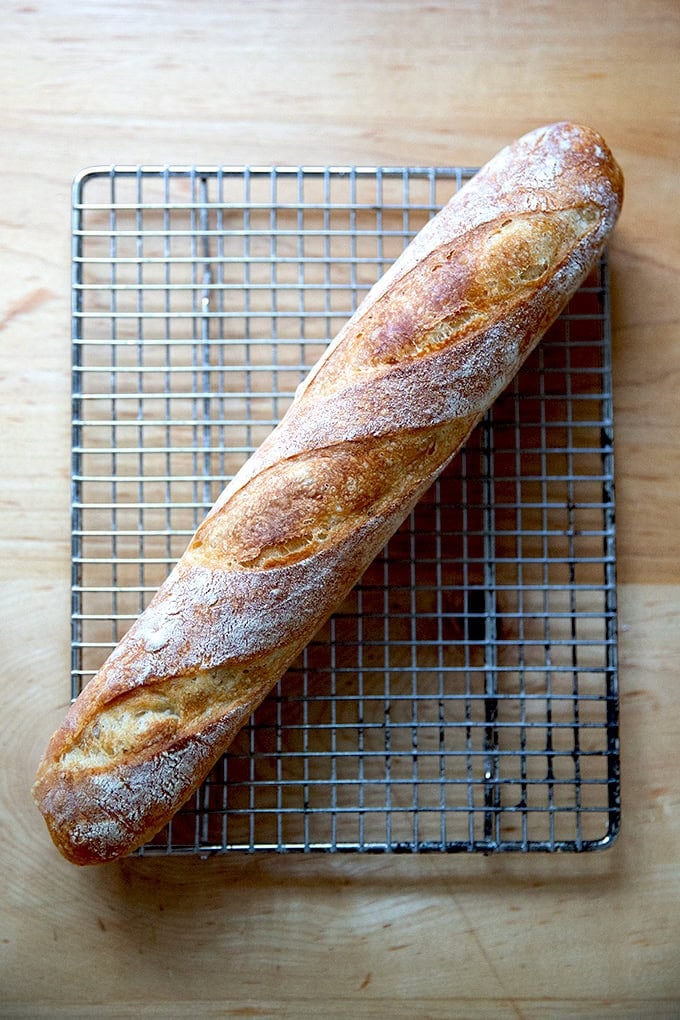

The crumb is the least open of the three methods, but the flavor is still great:
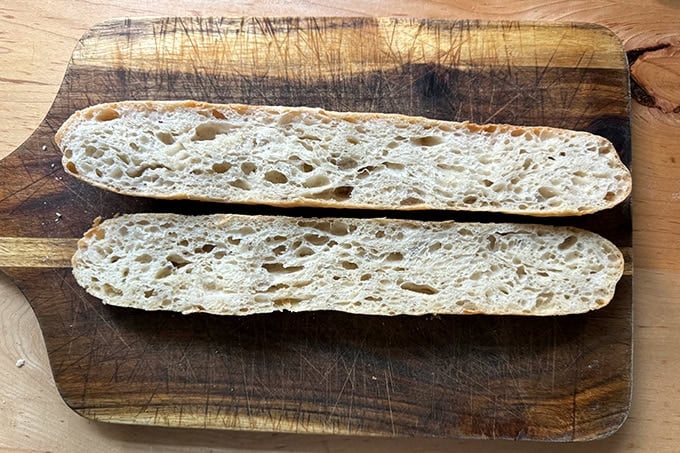

Description
Adapted from the outdoor variation of the Neapolitanish pizza dough recipe from my cookbook, Pizza Night.
Notes
- For best results, use a scale to measure everything.
- Flour: In most of my experiments I used King Arthur Bread flour but I also got excellent results and often an even more open crumb when I used Petra 0102 Flour, which is made from partially sprouted wheat.
- Salt: I use Diamond Crystal kosher salt, but you could use fine sea salt in its place. Again, for best results use a scale to measure. 16 grams of salt may seem like a lot, but the rule for bread and pizza dough is that the amount of salt should be 2 to 3% the weight of the flour. 16.5 grams is 3%; 11 grams is 2%. If you are using Diamond Crystal kosher salt, you’ll use roughly 5 teaspoons. If you are using Morton kosher salt or fine sea salt, you’ll use 2.5 teaspoons.
- Yeast: SAF instant yeast is my favorite.
Timing
Plan Ahead: This recipe calls for a long slow initial rise of roughly 6-10 hours followed, ideally, by some fridge time.
Example Timeline #1: Fridge Time
-
- Wednesday Evening: Mix Dough
-
- Thursday Morning: Ball Up Dough, Transfer to Fridge
-
- Friday Afternoon (or any subsequent afternoon for as long as a week): Remove Dough Ball From Fridge 3 Hours Prior to Baking
-
- Friday Evening: Bake Baguette
Example Timeline #2: No Fridge Time
-
- Thursday Evening: Mix Dough
-
- Friday Morning: Ball Up Dough, Transfer to a Lidded Vessel (such as a DoughMate), Leave at Room Temperature for Two Hours.
-
- Friday Midday: Shape the Dough Balls into Baguette Shape and Return to Lidded Vessel, Leave at Room Temperature for Roughly Two Hours More.
-
- Friday Afternoon: Bake the Baguettes
Three baking tools for baguettes:
Other Equipment:
- 550 grams (about 4¼ cups) bread flour or all-purpose flour, plus more for dusting, see notes above
- 15 to 16 grams salt, see notes above
- 2 grams (about ½ teaspoon) instant yeast, see notes above
- 385 grams (about 1 2/3 cups) cold (about 60°F) water
- Extra-virgin olive oil
- Mix the dough: In a large bowl, whisk together the flour, salt, and yeast. Add the water and use a spatula to mix until the dough comes together into a shaggy dough ball. If the dough is dry, use your hands to gently knead it in the bowl until it comes together. Cover the bowl with a towel and let rest for at least 15 minutes and up to 30 minutes.
- Stretch and fold: Fill a small bowl with water. Dip one hand into the bowl of water, then use the dry hand to stabilize the bowl while you grab an edge of the dough with your wet hand, pull up, and fold it toward the center. Repeat this stretching and folding motion 8 to 10 times, turning the bowl 90 degrees after each set. By the end, the dough should transform from shaggy in texture to smooth and cohesive.
- Pour about 1 teaspoon of olive oil over the dough and use your hands to rub it all over. Cover the bowl tightly and let the dough rise at room temperature until it has nearly doubled in volume, 6 to 10 hours. The time will vary depending on the time of year and the temperature of your kitchen.
- Portion the dough: Turn the dough out onto a lightly floured work surface and use a bench scraper to divide the dough into 4 equal portions, roughly 237 grams each. Using flour as needed, form each portion into a ball by grabbing the edges of the dough and pulling them toward the center to create a rough ball. Then flip the ball over, cup both your hands around the dough, and drag it toward you, creating tension as you pull. Repeat this cupping and dragging until you have a tight ball.
- Store the dough: Place the dough balls in individual airtight containers (see notes above) and transfer to the fridge for 1 to 3 days.
- Shape and proof the dough: On baking day, remove however many rounds of dough you wish to make into baguettes. Place on a clean work surface. I prefer to use no flour here, but if you are finding the dough to be too sticky, lightly flour your work surface. (Note: I suggest watching the video before you attempt shaping.) Pat the dough into roughly a 6 inch square or 6×7-inch rectangle. Fold the top down toward the center and pinch it gently. Turn the dough 180º and fold the top down again toward the center and pinch it gently (creating an “envelope”). Fold the top down again toward the center, pinching gently. Repeat one last time folding the top down all the way to end, pinching to seal the two halves together. (Again: Best to watch the video here!) Use both hand to gently roll the dough, then flip the log over and pinch the seam together. Flip the log over one last time, roll gently, then transfer to a lightly floured DoughMate container. (Alternatively you could use a 9×13-inch baking pan, which you will tuck inside a 2-gallon ziptop bag to create an airtight environment.) Roll the log in the flour, letting it rest seam-side down. Cover the vessel and let rest for 2.5 – 3 hours or until the dough passes the poke test: when it’s pressed gently, it springs back slowly.
- Prepare Your Baking Vessel of Choice:
- Challenger Bread Baker: After the dough has proofed for roughly 2 hours, place your Challenger bread pan in the oven on a middle rack and preheat it to 450ºF. This will take roughly 30 minutes. Fold a standard sheet of parchment paper in half vertically, and tear or cut along the seam.
- Baking Steel: After the dough has proofed for roughly 2 hours, place your Baking Steel in the oven on a middle rack, and preheat it to 450ºF. This will take roughly 30 minutes. Fold a standard sheet of parchment paper in half vertically, and tear or cut along the seam. Have the disposable aluminum pan at the ready as well as a small oven-safe skillet or vessel, strong enough to weigh down the pan without collapsing it.
- Emile Henry Baguette Baker: Butter your baguette baker and set aside. Preheat your oven to 450ºF (you do not preheat this vessel).
- Score your Dough: Open the lid of the DoughMate and gently roll the log back and forth a few times to release it from the bottom of the vessel. Use your hand to brush away the excess flour. If you are using the Challenger Bread Baker or Baking Steel, lift up the dough and transfer it to one of the parchment paper strips. Using a sharp blade, make three diagonal slashes evenly spaced along the top of the log. If you using something similar to the Emile Henry lidded baguette baker, simply transfer it to the buttered baker, then using a sharp blade, make three diagonal slashes evenly spaced along the top of the log.
- Bake Your Dough:
- Challenger Bread Baker: Using reliable oven mitts, remove the lid from the baker and lower the parchment sheet into the bottom of the pan, orienting it on the diagonal to allow for the most space. Cover the vessel. Close the oven. Bake for 10 minutes. Uncover and bake for 10 minutes more or until the baguette is evenly golden brown or to your liking.
- Baking Steel: Place the parchment sheet on a peel, and shimmy it parchment paper and all onto the steel. Cover with the aluminum pan. Place a small oven-safe skillet or something heavy enough to weigh the pan down without collapsing it. Bake for 10 minutes. Uncover and bake for 10 minutes more or until the baguette is evenly golden brown or to your liking.
- Emile Henry Baguette Baker: Your scored dough is in the baker (per step 8). Cover the vessel and transfer to your preheated oven (450ºF). Bake for 10 minutes. Uncover and bake for 10 minutes more or until the baguette is evenly golden brown or to your liking.
- Let Cool: Remove the baguette from the oven and let cool for 20-ish minutes before serving.
- Storing: Baguettes are best eaten the day they are made, but if you must store them, transfer them to a ziplock bag and store at room temperature for up to 3 days or in the freezer for up to 3 months. Always reheat before serving: 350ºF for 15 minutes or so.
- Prep Time: 2 days
- Cook Time: 20 minutes
- Category: Bread
- Method: Oven
- Cuisine: American, French
